When your motorcycle experiences a bit of a coolant hiccup, it can lead to more than just a minor inconvenience. You might wonder why this leakage happens in the first place, and understanding the underlying causes is vital. From worn seals to damaged hoses, several factors could be at play. It's important to know the signs and take preventive measures, but what steps can you take to effectively address these issues and keep your ride running smoothly? The answers might surprise you.
Quick Takeaways
- Worn seals and gaskets can lead to significant coolant leaks, necessitating regular inspections and prompt replacements.
- Damaged radiator hoses often cause coolant to escape; regular checks for cracks and bulges are crucial.
- Corrosion and clogs in the radiator can obstruct coolant flow, leading to overheating and leaks.
- Using the wrong type of coolant can result in chemical reactions, causing leaks; always follow the owner's manual recommendations.
Understanding Coolant Systems
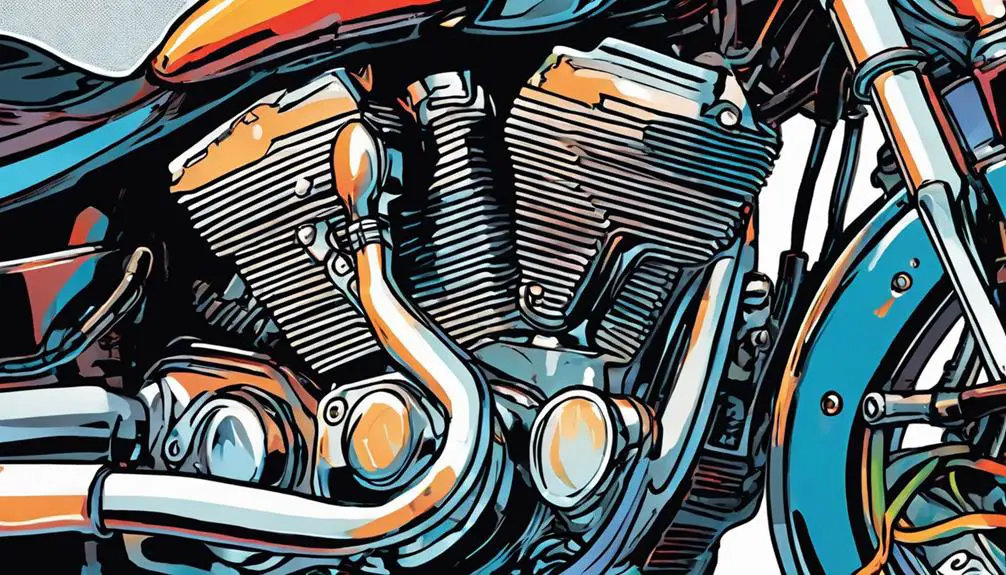
What makes coolant systems essential for your motorcycle's performance is their ability to regulate engine temperature and prevent overheating. When you ride, your engine generates heat, and without an effective coolant system, that heat can rise to dangerous levels.
This isn't just about keeping your bike running smoothly; it's about liberating your ride from the constraints of mechanical failure and ensuring you can explore the open road without fear.
Your coolant system circulates a mixture of coolant and water, absorbing heat from the engine and dissipating it through the radiator. This process helps maintain ideal operating temperatures, allowing your engine to perform at its best.
If your coolant system is working properly, you'll experience enhanced performance, better fuel efficiency, and prolonged engine life.
Common Causes of Leakage
When you're facing a coolant leak, it's often due to worn seals and gaskets or damaged radiator hoses.
These components play an essential role in keeping your motorcycle's cooling system intact.
Let's explore how these issues can lead to unwanted leaks and what you can do about them.
Worn Seals and Gaskets
Worn seals and gaskets can lead to significant coolant leaks, compromising your motorcycle's performance and engine health. These components play an essential role in maintaining a tight seal between various parts of your engine. Over time, exposure to heat, pressure, and harsh chemicals can cause them to degrade. When this happens, you might notice puddles of coolant forming beneath your bike or a drop in coolant levels.
To liberate your ride from these leaks, you'll need to inspect the seals and gaskets regularly. Look for signs of wear, such as cracks, bulges, or discoloration. If you spot any issues, replacing them promptly can prevent further damage and keep your bike running smoothly.
While some motorcycle owners might try to patch up leaks with sealants or temporary fixes, it's often a short-lived solution. Investing in high-quality replacement seals and gaskets will guarantee you maintain peak performance.
Damaged Radiator Hoses
Along with worn seals and gaskets, damaged radiator hoses are another common cause of coolant leaks that can affect your motorcycle's performance. These hoses carry coolant from the engine to the radiator and back, and if they're cracked, brittle, or improperly connected, you'll see a steady drip or puddle under your bike.
You might be tempted to ignore a small leak, but that's a dangerous game. The pressure in the cooling system can change dramatically, leading to overheating and serious engine damage. Check your hoses regularly for signs of wear and tear, especially at the clamps where they connect. If you notice any signs of damage, you'll need to replace them.
Don't let a simple hose issue compromise your freedom on the road. Replacing damaged radiator hoses is relatively straightforward and often a DIY project. By staying vigilant and proactive, you can maintain your bike's performance and guarantee your rides are as liberating as they should be.
Suzuki Motorcycle Coolant Types
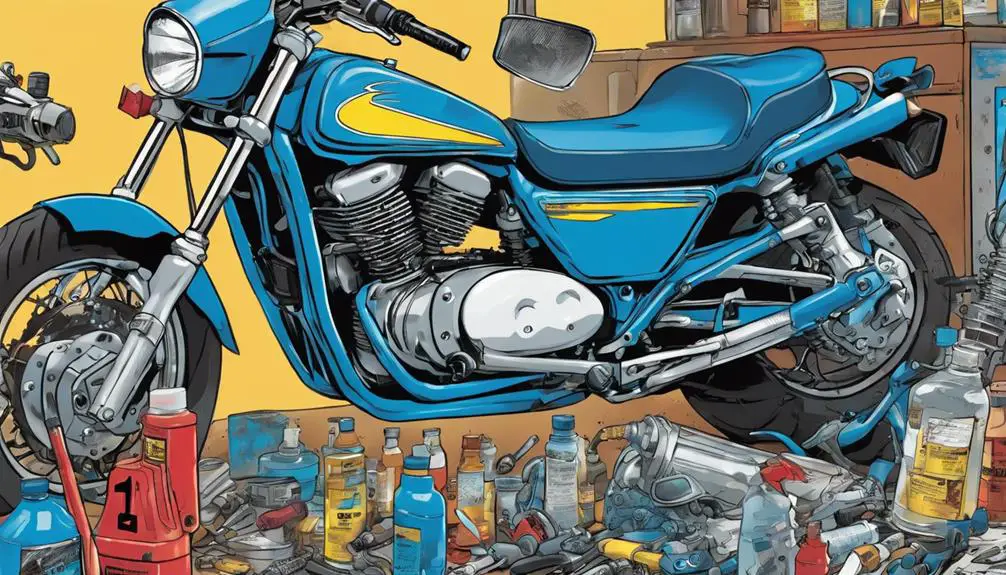
When it comes to Suzuki motorcycles, knowing the right coolant type is essential for peak performance.
You'll need to take into account the specific requirements for your model to select the best coolant.
Let's explore the different types available and how to choose the right one for your ride.
Types of Suzuki Coolant
Suzuki motorcycles typically use specific types of coolant designed to optimize engine performance and longevity. Understanding these coolants can empower you to make informed choices for your ride. Here's a breakdown of the main types:
- Ethylene Glycol: This is the most common coolant type, offering excellent heat transfer and protection against freezing and boiling.
- Propylene Glycol: Safer for the environment, this coolant is less toxic but still effective in preventing corrosion and overheating.
- Silicate-Based Coolants: These provide superior protection against corrosion, particularly in aluminum engines, but should be used with caution as they can cause deposits.
- Organic Acid Technology (OAT): This long-lasting coolant is designed for extended intervals between changes, focusing on engine protection and environmental safety.
Selecting the Right Coolant
Choosing the right coolant for your Suzuki motorcycle is essential to maintaining ideal engine performance and preventing overheating. You've got options, and selecting the right one can make all the difference.
Suzuki typically recommends either ethylene glycol or propylene glycol-based coolants. Ethylene glycol coolants are widely used due to their excellent heat transfer properties, while propylene glycol is a safer alternative for those concerned about environmental impact.
When selecting your coolant, look for one that meets Suzuki's specifications, often labeled as “silicate-free” or “organic acid technology (OAT).” These types are formulated to protect your engine and cooling system from rust and corrosion.
Avoid mixing different coolant types, as that can lead to chemical reactions that may damage your system.
Check your owner's manual for specific recommendations tailored to your model. Investing in the right coolant liberates you from the constant worry of overheating and costly repairs.
Regularly checking and replacing your coolant keeps your engine running smoothly, allowing you to enjoy every ride with confidence. Make the choice that empowers your motorcycle experience, and ride on without fear!
Inspecting for Coolant Leaks
Regularly inspecting your motorcycle for coolant leaks is essential to guarantee peak performance and prevent engine damage. Taking the time to check for leaks not only preserves your ride but also liberates you from the stress of unexpected breakdowns. Here's how to do it effectively:
- Check the Radiator: Look for any visible signs of leakage around the radiator. A wet surface or stains indicate a potential issue.
- Inspect the Hoses: Examine all coolant hoses for cracks or wear. Any bulging or softness could signal a leak waiting to happen.
- Look Under the Bike: After a ride, check the ground under your motorcycle. A puddle of coolant is a clear sign something's amiss.
- Monitor Coolant Levels: Regularly check your coolant reservoir. A drop in levels without an apparent leak can hint at hidden issues.
Seals and Gaskets Overview
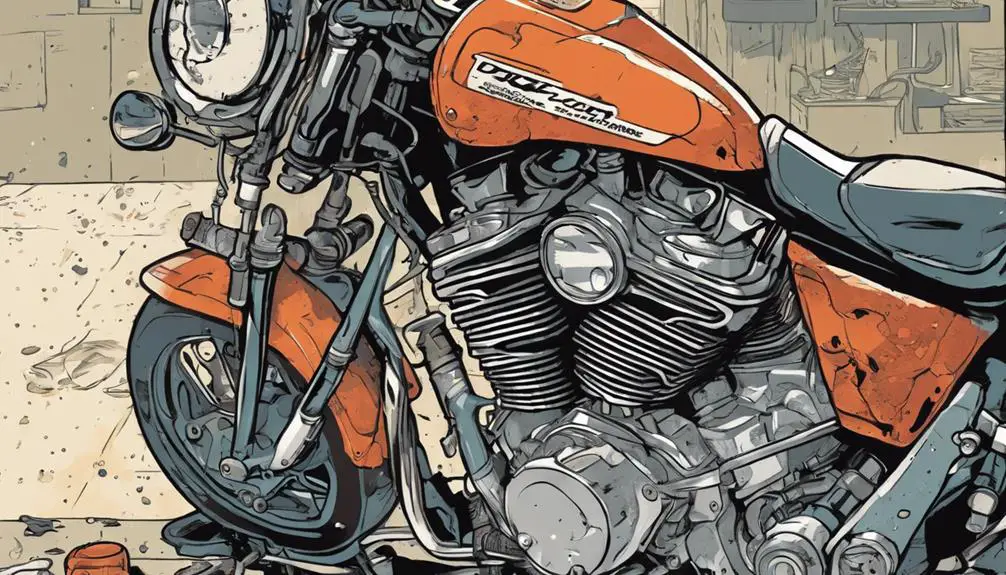
Seals and gaskets play an essential role in preventing coolant leaks by creating a tight seal between engine components, guaranteeing that fluids remain contained. When these components wear out or get damaged, you're at risk of leaks that can lead to overheating and engine damage.
You should regularly check these critical parts because they can deteriorate over time due to extreme temperatures, vibrations, and exposure to chemicals. If you notice any signs of leaks or coolant stains, it's important to inspect your seals and gaskets.
Replacing worn-out seals and gaskets isn't just about maintaining your bike; it's about liberating your ride from the potential chaos of engine failure. Using high-quality materials for replacements can make a significant difference in performance and longevity.
Don't underestimate the significance of routine maintenance. Keeping seals and gaskets in good shape guarantees your motorcycle runs smoothly, allowing you to embrace the open road with confidence.
Radiator Issues in Suzuki
If you own a Suzuki motorcycle, you might encounter some common radiator problems.
It's vital to recognize the signs of leakage early on, as they can lead to more significant issues.
We'll also cover essential repair and maintenance tips to keep your radiator in top shape.
Common Radiator Problems
Radiator issues in Suzuki motorcycles can lead to overheating and coolant leaks, causing frustration for riders. Understanding common radiator problems can help you maintain your bike and enjoy a smoother ride. Here are four prevalent issues to watch out for:
- Corrosion: Over time, the radiator can corrode due to exposure to coolant and environmental factors. This not only weakens the radiator but can also lead to leaks.
- Clogs: Dirt and debris can accumulate inside the radiator, obstructing coolant flow. This can cause overheating, as the coolant can't circulate effectively.
- Damaged Hoses: The hoses connected to your radiator can crack or become loose, leading to coolant leaks. It's essential to inspect these regularly.
- Faulty Thermostat: If the thermostat fails, it may not regulate coolant flow properly, leading to overheating and potential damage to the engine.
Signs of Leakage
You might frequently notice signs of coolant leakage in your Suzuki motorcycle, which can indicate underlying radiator issues. One of the most obvious signs is a puddle of green, orange, or pink fluid forming beneath your bike. This fluid is coolant, and its presence means you need to investigate further.
Another sign to watch for is a drop in your engine temperature. If your motorcycle's temperature gauge starts fluctuating or rises unexpectedly, it could mean your radiator isn't circulating coolant properly due to a leak. Pay attention to any hissing sounds, too; they often signal steam escaping from a compromised radiator.
You might also detect a sweet smell, which is characteristic of coolant. If you notice any of these symptoms, don't ignore them. They can lead to more serious engine problems if left unchecked.
Inspecting your radiator for visible cracks or corrosion can help you catch issues early. Regularly checking your coolant levels is essential as well. By being aware of these signs, you empower yourself to take action and maintain your Suzuki, ensuring your ride remains smooth and liberating.
Repair and Maintenance Tips
Proper maintenance is essential for preventing radiator issues in your Suzuki motorcycle and keeping it in top shape. By staying proactive, you can avoid costly repairs and enjoy the freedom of the open road without interruptions. Here are some key tips to follow:
- Inspect Regularly: Check your radiator for any signs of wear, damage, or leaks. Look for corrosion, cracks, or loose connections that could lead to coolant loss.
- Flush the System: Regularly flushing the coolant system helps prevent buildup and guarantees your radiator operates efficiently. Follow the manufacturer's guidelines for the right intervals.
- Use the Right Coolant: Always use the recommended coolant for your Suzuki. Using the wrong type can lead to corrosion and overheating issues.
- Monitor Temperature: Keep an eye on your engine temperature gauge. If it runs too hot, it may indicate radiator problems that need immediate attention.
Hose and Clamp Maintenance
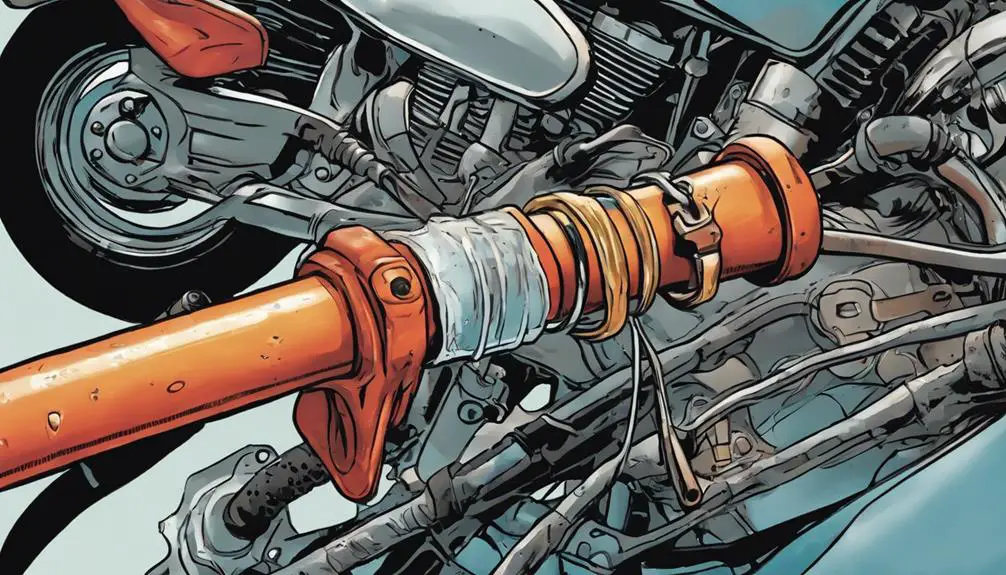
Maintaining hoses and clamps is essential for preventing coolant leaks in your motorcycle. These components endure a lot of pressure and heat, so regular checks can save you from bigger headaches down the road. Start by inspecting hoses for cracks, bulges, or wear. If you spot any damage, it's time to replace them. Remember, a small crack can lead to a significant leak, disrupting your ride.
Next, focus on clamps. They should fit snugly around hoses to guarantee a tight seal. Over time, clamps can rust or lose their grip, leading to leaks. Tighten any loose clamps, but don't overtighten, as that can cause more damage. If you notice rust or wear, swapping out old clamps for new ones is a smart move.
Don't forget about the coolant itself. When you maintain your hoses and clamps, check the coolant levels too. Keeping everything in good shape allows you to feel the freedom of the open road without worrying about leaks.
Coolant Replacement Procedures
After confirming hoses and clamps are in good condition, it's time to focus on the coolant replacement procedures that keep your motorcycle running smoothly. Follow these steps to liberate your ride from overheating:
- Gather Supplies: You'll need new coolant, a funnel, a container for old coolant, and a wrench to remove the drain plug.
- Drain Old Coolant: Locate the drain plug, position your container underneath, and carefully remove the plug to let the old coolant flow out. This is your chance to release any built-up pressure.
- Flush the System: After draining, use distilled water to flush the system. Pour it in and run the engine for a few minutes, allowing it to circulate before draining again. This step confirms any remnants of old coolant are gone.
- Refill with New Coolant: Using a funnel, pour in the new coolant until it reaches the appropriate level. Make sure to follow the manufacturer's recommendations for the right type and mixture.
Once done, run the engine again, check for leaks, and enjoy the freedom of a well-maintained motorcycle. Your ride deserves this attention!
Preventative Measures to Take
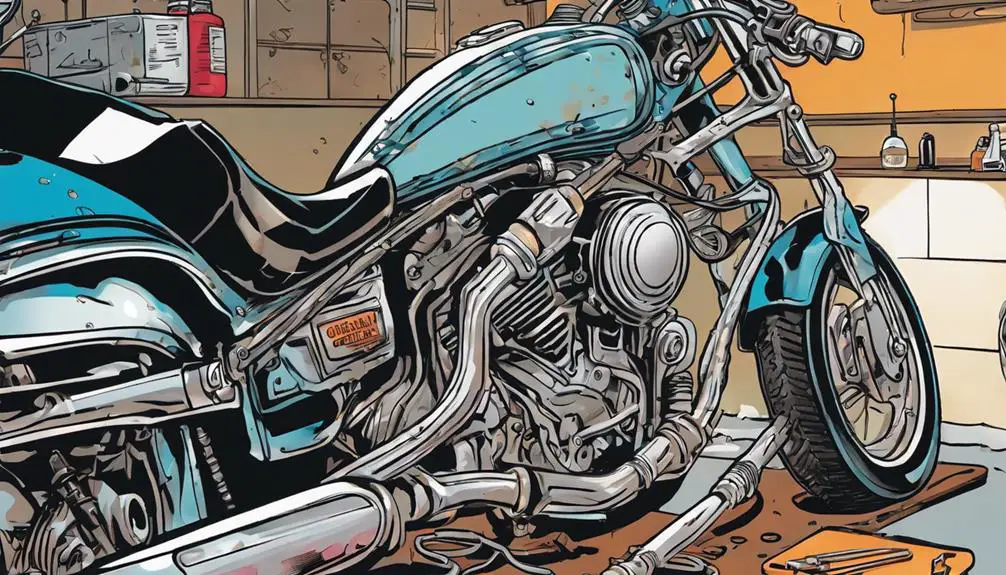
Taking proactive steps can greatly reduce the chances of coolant leaks in your motorcycle.
First, regularly check your coolant levels and inspect for any visible signs of leaks. A quick glance at the hoses and connections can save you from bigger issues down the road. If you spot any cracks or wear, replace those components immediately.
Next, maintain your bike's cooling system by flushing and replacing the coolant as recommended by the manufacturer. Fresh coolant helps prevent corrosion and buildup that can lead to leaks.
Don't forget to check the radiator cap, too. A faulty cap can cause pressure issues, leading to leaks. Make sure it fits snugly and isn't damaged.
Lastly, consider riding your motorcycle regularly. A bike that sits too long can develop issues, including coolant leaks, due to stagnation and lack of movement.
Professional Repair Options
When coolant leaks occur, seeking professional repair options can provide the expertise needed to address the issue effectively and restore your motorcycle's performance. You deserve a ride that's reliable, and professionals can guarantee your bike gets the care it needs.
Here are four reasons to contemplate professional help:
- Expert Diagnosis: Technicians can pinpoint the exact source of the leak, saving you time and frustration.
- Quality Repairs: Professionals use high-quality parts and tools, guaranteeing repairs are durable and dependable.
- Safety Assurance: A skilled mechanic understands the implications of coolant leaks on your bike's system, keeping you safe on the road.
- Warranty Protection: Many shops offer warranties on their repairs, giving you peace of mind in case issues arise later.
Taking your motorcycle to a professional isn't just about fixing a leak; it's about liberating your ride from potential hazards. Trust the experts to help you reclaim the joy of riding, free from worries about overheating or damage.
Your motorcycle deserves the best care, so embrace the journey and ride with confidence.
Common Questions
How Can I Identify Coolant Leaks Early on My Motorcycle?
To identify coolant leaks early on your motorcycle, regularly check for puddles or stains beneath it.
Inspect hoses and connections for cracks or wear, and look for corrosion around the radiator.
Pay attention to your temperature gauge; if it's running hotter than usual, that's a red flag.
Keep an eye on your coolant levels and look for any signs of steam or unusual smells when you ride.
Trust your instincts!
What Are the Symptoms of Low Coolant Levels in Motorcycles?
When you notice your motorcycle overheating, it's a clear sign of low coolant levels.
You might also see the temperature gauge climbing higher than usual or hear unusual noises from the engine.
If you spot any steam coming from the radiator or the engine area, don't ignore it.
A sweet smell from the exhaust could indicate coolant issues too.
Staying alert to these symptoms can help you protect your ride's performance and longevity.
Can I Use Water Instead of Coolant Temporarily?
Imagine your motorcycle as a ship steering through turbulent seas.
When coolant levels drop, you're tempted to toss in water, thinking it'll keep your journey smooth just for now.
While it can be a temporary lifeline, using water instead of coolant can lead to corrosion and overheating in the long run.
You're better off seeking a proper coolant, ensuring your vessel stays strong and ready to conquer the open road ahead.
How Often Should I Check My Motorcycle's Coolant Levels?
You should check your motorcycle's coolant levels at least once a month, or more often if you ride frequently.
After long trips or in extreme temperatures, it's wise to inspect it too.
Keeping an eye on the coolant guarantees your engine runs smoothly and prevents overheating.
Don't wait for warning lights; make it part of your routine.
Regular checks empower you to maintain your bike and enjoy the open road worry-free.
Is It Safe to Ride With a Coolant Leak?
It's tempting to ride with a coolant leak, thinking it's just a minor issue, but you're risking serious engine damage.
If your bike's overheating, it's not safe to continue riding. You deserve a smooth, reliable ride, and riding with a coolant leak could leave you stranded.
Prioritize your safety and your bike's health—address the leak before hitting the road. You'll enjoy your freedom much more knowing you've got everything in check!
Wrapping Up
To sum up, keeping your motorcycle's coolant system in top shape is like giving it a rejuvenating drink on a hot day.
By staying vigilant about inspections and maintenance, you can catch leaks before they turn into bigger issues.
Remember to replace worn seals and hoses, and choose the right coolant for your bike.
With a little care, you'll guarantee your ride stays cool, smooth, and ready to hit the road whenever you are!